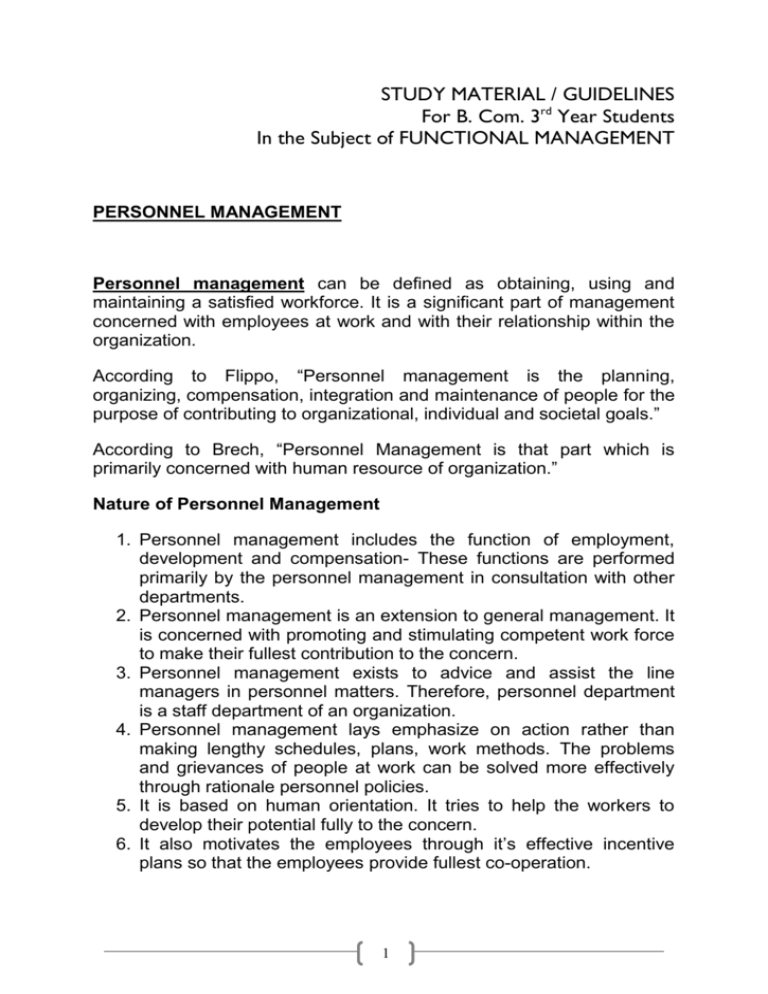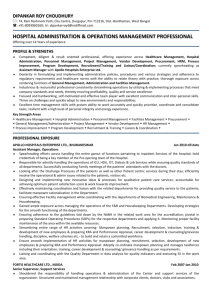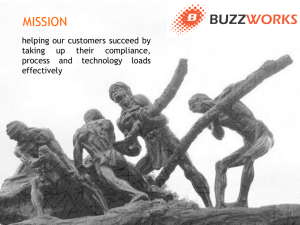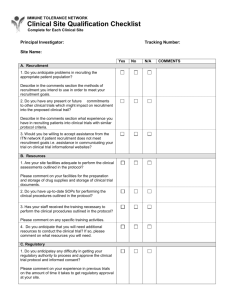Personnel management can be defined as obtaining, using and
advertisement

STUDY MATERIAL / GUIDELINES For B. Com. 3rd Year Students In the Subject of FUNCTIONAL MANAGEMENT PERSONNEL MANAGEMENT Personnel management can be defined as obtaining, using and maintaining a satisfied workforce. It is a significant part of management concerned with employees at work and with their relationship within the organization. According to Flippo, “Personnel management is the planning, organizing, compensation, integration and maintenance of people for the purpose of contributing to organizational, individual and societal goals.” According to Brech, “Personnel Management is that part which is primarily concerned with human resource of organization.” Nature of Personnel Management 1. Personnel management includes the function of employment, development and compensation- These functions are performed primarily by the personnel management in consultation with other departments. 2. Personnel management is an extension to general management. It is concerned with promoting and stimulating competent work force to make their fullest contribution to the concern. 3. Personnel management exists to advice and assist the line managers in personnel matters. Therefore, personnel department is a staff department of an organization. 4. Personnel management lays emphasize on action rather than making lengthy schedules, plans, work methods. The problems and grievances of people at work can be solved more effectively through rationale personnel policies. 5. It is based on human orientation. It tries to help the workers to develop their potential fully to the concern. 6. It also motivates the employees through it’s effective incentive plans so that the employees provide fullest co-operation. 1 7. Personnel management deals with human resources of a concern. In context to human resources, it manages both individual as well as blue- collar workers. Role of Personnel Manager Personnel manager is the head of personnel department. He performs both managerial and operative functions of management. His role can be summarized as: 1. Personnel manager provides assistance to top managementThe top management are the people who decide and frame the primary policies of the concern. All kinds of policies related to personnel or workforce can be framed out effectively by the personnel manager. 2. He advices the line manager as a staff specialist- Personnel manager acts like a staff advisor and assists the line managers in dealing with various personnel matters. 3. As a counselor, - As a counselor, personnel manager attends problems and grievances of employees and guides them. He tries to solve them in best of his capacity. 4. Personnel manager acts as a mediator- He is a linking pin between management and workers. 5. He acts as a spokesman- Since he is in direct contact with the employees, he is required to act as representative of organization in committees appointed by government. He represents company in training programmes. Functions of Personnel Management Following are the four functions of Personnel Management: a) Manpower Planning which is also called as Human Resource Planning consists of putting right number of people, right kind of people at the right place, right time, doing the right things for which they are suited for the achievement of goals of the organization. Human Resource Planning has got an important place in the arena of industrialization. Human Resource Planning has to be a systems approach and is carried out in a set procedure. The procedure is as follows: 1. Analyzing the current manpower inventory 2 2. Making future manpower forecasts 3. Developing employment programmes 4. Design training programmes Steps in Manpower Planning 1. Analyzing the current manpower inventory- Before a manager makes forecast of future manpower, the current manpower status has to be analyzed. For this the following things have to be notedType of organization Number of departments Number and quantity of such departments Employees in these work units Once these factors are registered by a manager, he goes for the future forecasting. 2. Making future manpower forecasts- Once the factors affecting the future manpower forecasts are known, planning can be done for the future manpower requirements in several work units. The Manpower forecasting techniques commonly employed by the organizations are as follows: i. ii. iii. iv. v. Expert Forecasts: This includes informal decisions, formal expert surveys and Delphi technique. Trend Analysis: Manpower needs can be projected through extrapolation (projecting past trends), indexation (using base year as basis), and statistical analysis (central tendency measure). Work Load Analysis: It is dependent upon the nature of work load in a department, in a branch or in a division. Work Force Analysis: Whenever production and time period has to be analyzed, due allowances have to be made for getting net manpower requirements. Other methods: Several Mathematical models, with the aid of computers are used to forecast manpower needs, like budget and planning analysis, regression, new venture analysis. 3. Developing employment programmes- Once the current inventory is compared with future forecasts, the employment programmes can be framed and developed accordingly, which will include recruitment, selection procedures and placement plans. 3 4. Design training programmes- These will be based upon extent of diversification, expansion plans, development programmes, etc. Training programmes depend upon the extent of improvement in technology and advancement to take place. It is also done to improve upon the skills, capabilities, knowledge of the workers. b) Recruitment: 1. Internal Recruitment – is a recruitment which takes place within the concern or organization. Internal sources of recruitment are readily available to an organization. Internal sources are primarily three – Transfers, promotions and Re-employment of ex-employees. Reemployment of ex-employees is one of the internal sources of recruitment in which employees can be invited and appointed to fill vacancies in the concern. There are situations when ex-employees provide unsolicited applications also. Internal recruitment may lead to increase in employee’s productivity as their motivation level increases. It also saves time, money and efforts. But a drawback of internal recruitment is that it refrains the organization from new blood. Also, not all the manpower requirements can be met through internal recruitment. Hiring from outside has to be done. Internal sources are primarily 3 a. Transfers b. Promotions (through Internal Job Postings) and c. Re-employment of ex-employees - Re-employment of exemployees is one of the internal sources of recruitment in which employees can be invited and appointed to fill vacancies in the concern. There are situations when ex-employees provide unsolicited applications also. 2. External Recruitment – External sources of recruitment have to be solicited from outside the organization. External sources are external to a concern. But it involves lot of time and money .The external sources of recruitment include – Employment at factory gate, advertisements, employment exchanges, employment agencies, educational institutes, labour contractors, recommendations etc. a. Employment at Factory Level – This a source of external recruitment in which the applications for vacancies are presented on bulletin boards outside the Factory or at the Gate. This kind of recruitment is applicable generally where 4 factory workers are to be appointed. There are people who keep on soliciting jobs from one place to another. These applicants are called as unsolicited applicants. These types of workers apply on their own for their job. For this kind of recruitment workers have a tendency to shift from one factory to another and therefore they are called as “badli” workers. b. Advertisement – It is an external source which has got an important place in recruitment procedure. The biggest advantage of advertisement is that it covers a wide area of market and scattered applicants can get information from advertisements. Medium used is Newspapers and Television. c. Employment Exchanges – There are certain Employment exchanges which are run by government. Most of the government undertakings and concerns employ people through such exchanges. Now-a-days recruitment in government agencies has become compulsory through employment exchange. d. Employment Agencies – There are certain professional organizations which look towards recruitment and employment of people, i.e. these private agencies run by private individuals supply required manpower to needy concerns. e. Educational Institutions – There are certain professional Institutions which serve as an external source for recruiting fresh graduates from these institutes. This kind of recruitment done through such educational institutions is called as Campus Recruitment. They have special recruitment cells which help in providing jobs to fresh candidates. f. Recommendations – There are certain people who have experience in a particular area. They enjoy goodwill and a stand in the company. There are certain vacancies which are filled by recommendations of such people. The biggest drawback of this source is that the company has to rely totally on such people which can later on prove to be inefficient. 5 g. Labour Contractors – These are the specialist people who supply manpower to the Factory or Manufacturing plants. Through these contractors, workers are appointed on contract basis, i.e. for a particular time period. Under conditions when these contractors leave the organization, such people who are appointed have to also leave the concern. c) Selection: The Employee selection Process takes place in following order1. Preliminary Interviews- It is used to eliminate those candidates who do not meet the minimum eligibility criteria laid down by the organization. The skills, academic and family background, competencies and interests of the candidate are examined during preliminary interview. Preliminary interviews are less formalized and planned than the final interviews. The candidates are given a brief up about the company and the job profile; and it is also examined how much the candidate knows about the company. Preliminary interviews are also called screening interviews. 2. Application blanks- The candidates who clear the preliminary interview are required to fill application blank. It contains data record of the candidates such as details about age, qualifications, reason for leaving previous job, experience, etc. 3. Written Tests- Various written tests conducted during selection procedure are aptitude test, intelligence test, reasoning test, personality test, etc. These tests are used to objectively assess the potential candidate. They should not be biased. 4. Employment Interviews- It is a one to one interaction between the interviewer and the potential candidate. It is used to find whether the candidate is best suited for the required job or not. But such interviews consume time and money both. Moreover the competencies of the candidate cannot be judged. Such interviews may be biased at times. Such interviews should be conducted properly. No distractions should be there in room. There should be an honest communication between candidate and interviewer. 6 5. Medical examination- Medical tests are conducted to ensure physical fitness of the potential employee. It will decrease chances of employee absenteeism. 6. Appointment Letter- A reference check is made about the candidate selected and then finally he is appointed by giving a formal appointment letter. d) Training: Training is generally imparted in two ways: 1. On the job training- On the job training methods are those which are given to the employees within the everyday working of a concern. It is a simple and cost-effective training method. The inproficient as well as semi- proficient employees can be well trained by using such training method. The employees are trained in actual working scenario. The motto of such training is “learning by doing.” Instances of such on-job training methods are job-rotation, coaching, temporary promotions, etc. 2. Off the job training- Off the job training methods are those in which training is provided away from the actual working condition. It is generally used in case of new employees. Instances of off the job training methods are workshops, seminars, conferences, etc. Such method is costly and is effective if and only if large number of employees have to be trained within a short time period. Off the job training is also called as vestibule training, i.e., the employees are trained in a separate area (may be a hall, entrance, reception area, etc. known as a vestibule) where the actual working conditions are duplicated. MARKETING MANAGEMENT Marketing Management is a business discipline which is focused on the practical application of marketing techniques and the management of a firm's marketing resources and activities. Rapidly emerging forces of globalization have compelled firms to market beyond the borders of their home country making International marketing highly significant and an integral part of a firm's marketing strategy.[1] Marketing managers are often responsible for influencing the level, timing, and composition of customer demand accepted definition of the term. In part, this is 7 because the role of a marketing manager can vary significantly based on a business' size, corporate, and industry context. For example, in a large consumer products company, the marketing manager may act as the overall general manager of his or her assigned product[2] To create an effective, cost-efficient Marketing management strategy, firms must possess a detailed, objective understanding of their own business and the market in which they operate.[3]In analyzing these issues, the discipline of marketing management often overlaps with the related discipline of strategic planning. MARKET SEGMENTATION Market segmentation is a concept in economics and marketing. A market segment is a sub-set of a market made up of people or organizations with one or more characteristics that cause them to demand similar product and/or services based on qualities of those products such as price or function. A true market segment meets all of the following criteria: it is distinct from other segments (different segments have different needs), it is homogeneous within the segment (exhibits common needs); it responds similarly to a market stimulus, and it can be reached by a market intervention. The term is also used when consumers with identical product and/or service needs are divided up into groups so they can be charged different amounts. These can broadly be viewed as 'positive' and 'negative' applications of the same idea, splitting up the market into smaller groups. Examples: Gender Price Interests While there may be theoretically 'ideal' market segments, in reality every organization engaged in a market will develop different ways of imagining market segments, and create Product differentiation strategies to exploit these segments. The market segmentation and corresponding product differentiation strategy can give a firm a temporary commercial advantage. MARKET RESEARCH Market research is any organized effort to gather information about markets or customers. It is a very important component of business strategy.[1] The term is commonly interchanged 8 with marketing research; however, expert practitioners may wish to draw a distinction, in that marketing research is concerned specifically about marketing processes, while market research is concerned specifically with markets.[2] Market research, as defined by the ICC/ESOMAR International Code on Market and Social Research, includes social and opinion research, [and] is the systematic gathering and interpretation of information about individuals or organizations using statistical and analytical methods and techniques of the applied social sciences to gain insight or support decision making.[3] FINANCIAL MANAGEMENT Meaning of Financial Management Financial Management means planning, organizing, directing and controlling the financial activities such as procurement and utilization of funds of the enterprise. It means applying general management principles to financial resources of the enterprise. Scope/Elements 1. Investment decisions includes investment in fixed assets (called as capital budgeting).Investment in current assets are also a part of investment decisions called as working capital decisions. 2. Financial decisions - They relate to the raising of finance from various resources which will depend upon decision on type of source, period of financing, cost of financing and the returns thereby. 3. Dividend decision - The finance manager has to take decision with regards to the net profit distribution. Net profits are generally divided into two: a. Dividend for shareholders- Dividend and the rate of it has to be decided. b. Retained profits- Amount of retained profits has to be finalized which will depend upon expansion and diversification plans of the enterprise. Objectives of Financial Management 9 The financial management is generally concerned with procurement, allocation and control of financial resources of a concern. The objectives can be1. To ensure regular and adequate supply of funds to the concern. 2. To ensure adequate returns to the shareholders which will depend upon the earning capacity, market price of the share, expectations of the shareholders. 3. To ensure optimum funds utilization. Once the funds are procured, they should be utilized in maximum possible way at least cost. 4. To ensure safety on investment, i.e., funds should be invested in safe ventures so that adequate rate of return can be achieved. 5. To plan a sound capital structure-There should be sound and fair composition of capital so that a balance is maintained between debt and equity capital. Functions of Financial Management 1. Estimation of capital requirements: A finance manager has to make estimation with regards to capital requirements of the company. This will depend upon expected costs and profits and future programmes and policies of a concern. Estimations have to be made in an adequate manner which increases earning capacity of enterprise. 2. Determination of capital composition: Once the estimation has been made, the capital structure have to be decided. This involves short- term and long- term debt equity analysis. This will depend upon the proportion of equity capital a company is possessing and additional funds which have to be raised from outside parties. 3. Choice of sources of funds: For additional funds to be procured, a company has many choices likea. Issue of shares and debentures b. Loans to be taken from banks and financial institutions c. Public deposits to be drawn like in form of bonds. Choice of factor will depend on relative merits and demerits of each source and period of financing. 4. Investment of funds: The finance manager has to decide to allocate funds into profitable ventures so that there is safety on investment and regular returns is possible. 10 5. Disposal of surplus: The net profits decision has to be made by the finance manager. This can be done in two ways: a. Dividend declaration - It includes identifying the rate of dividends and other benefits like bonus. b. Retained profits - The volume has to be decided which will depend upon expansion, innovational, diversification plans of the company. 6. Management of cash: Finance manager has to make decisions with regards to cash management. Cash is required for many purposes like payment of wages and salaries, payment of electricity and water bills, payment to creditors, meeting current liabilities, maintenance of enough stock, purchase of raw materials, etc. 7. Financial controls: The finance manager has not only to plan, procure and utilize the funds but he also has to exercise control over finances. This can be done through many techniques like ratio analysis, financial forecasting, cost and profit control, etc. Compiled by Ms. Rashida Lecturer Commerce PG Deptt. of Commerce and Management Govt. Degree College Bemina 11







